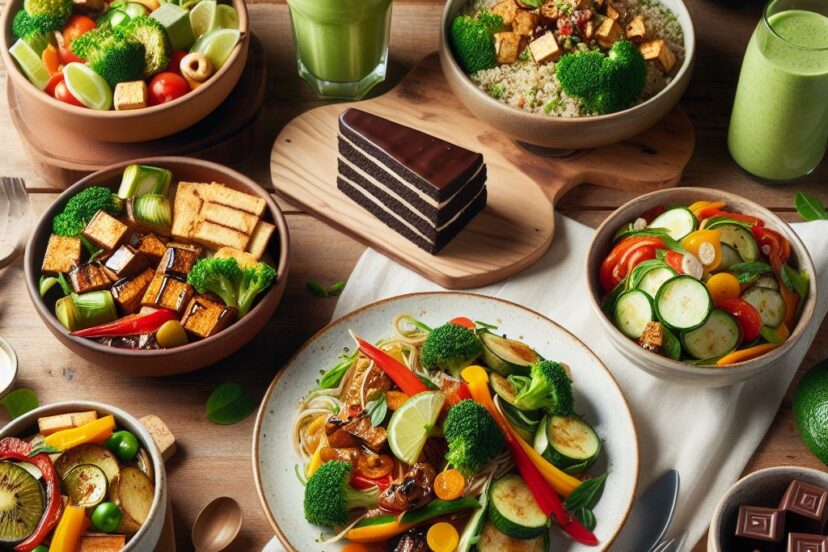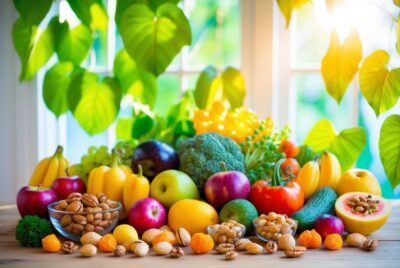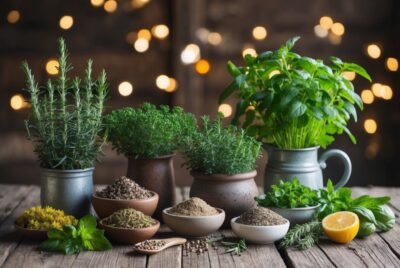Vegan Diet Plan: Your Roadmap to a Delicious Lifestyle
*We may earn a commission for purchases made using our links. Please see our disclosure to learn more.
Vegan Diet Plan: A Comprehensive Guide for Beginners
Embarking on a vegan diet plan involves more than just a culinary change; it’s a lifestyle adjustment that benefits not only personal health but also the environment. By choosing plant-based foods, I ensure that my meals are abundant in whole foods such as fruits, vegetables, grains, nuts, and seeds. This approach is grounded in the philosophy of veganism, which involves abstaining from all animal products and byproducts.

In my experience, thorough research and planning are vital to maintain a balanced vegan diet. Understanding the nutritional content and health benefits of various plant-based ingredients helps in crafting meals that not only satisfy taste buds but also meet dietary needs. It’s a common misconception that a vegan diet lacks sufficient protein, but with legumes, tofu, tempeh, and a variety of plant-based protein powders available, meeting protein requirements is quite manageable.
The environmental impact of my dietary choices is significant. The evidence indicates a positive correlation between plant-based diets and a reduction in carbon footprint, conservation of water, and a decrease in the demand for resources that are typically strained by traditional farming practices. By following a vegan diet, I am conscious that my food choices contribute to a more sustainable and ethical world.
Understanding Veganism

In my exploration of veganism, I focus on its health attributes and environmental considerations, pinpointing how it contributes to personal wellbeing and ecological sustainability.
Health Benefits
Adopting a vegan diet can be transformative for personal health, primarily through the consumption of nutrient-dense foods. Plant-based diets are rich in dietary fiber, vitamins, and minerals. Empirical data suggests that vegans may have a lower risk of heart disease, certain cancers, and type 2 diabetes. Additionally, a well-planned vegan diet can aid in weight loss and cholesterol management by emphasizing whole grains, fruits, vegetables, legumes, nuts, and seeds.
| Nutrient | Plant-based Sources |
|---|---|
| Protein | Lentils, chickpeas, tofu, seitan |
| Iron | Spinach, legumes, quinoa, pumpkin seeds |
| Omega-3 Fatty Acids | Chia seeds, flaxseeds, walnuts |
| Calcium | Fortified plant milk, tahini, kale |
| Vitamin B12 | Fortified foods, nutritional yeast |
Environmental Impact
My investigation into the environmental impact of veganism indicates that plant-based diets can significantly reduce one’s carbon footprint. The livestock sector is a major contributor to greenhouse gas emissions and agricultural deforestation. By eliminating animal products, vegans inherently decrease the demand for resources that fuel these environmental stresses. It’s not just about reducing emissions; it’s also about the conservation of water and land.
Nutritional Foundations

When adopting a vegan diet, it’s crucial to understand the nutritional makeup to ensure all dietary needs are met. I’ll explore the macronutrients followed by key vitamins and minerals that are vital for health.
Macronutrients in a Vegan Diet
Protein: It’s a myth that vegans can’t get enough protein. I focus on consuming a variety of plant-based proteins such as legumes, nuts, seeds, and whole grains. For example, lentil chili and black bean salad are great sources. A vegan protein shake can also supplement my intake.
Fat: Healthy fats are essential, and I find them in foods like avocados, nuts, and seeds. These sources provide me with omega-3 and omega-6 fatty acids, important for brain function and cellular health.
Fiber: A vegan diet is naturally rich in fiber due to the consumption of whole grains, fruits, and vegetables. Fiber aids in digestion and can help regulate blood sugar levels.
Calories: I monitor my calorie intake to ensure it meets my energy requirements, considering factors like age, activity level, and metabolism. Vegan meals can vary greatly in caloric content, so portion control and meal planning are key.
Vital Vitamins and Minerals
Iron: To maintain adequate iron levels, I include iron-rich plant foods, such as spinach, beans, and fortified cereals in my meals. Pairing these with vitamin C-rich foods can enhance absorption.
Vitamin B12: Since B12 is not naturally present in a vegan diet, I look for fortified foods or take a B12 supplement to prevent deficiency.
Supplements: Depending on my dietary choices, I may need additional supplements like vitamin D, omega-3s, or iodine. It’s important I consult with a healthcare professional to tailor supplementation to my needs.
Protein Sources: Aside from legumes and protein shakes mentioned earlier, tofu, tempeh, and seitan are standard in my kitchen. These versatile ingredients can be used in a variety of dishes to diversify my protein sources.
Plant-Based Meal Planning

When creating a vegan meal plan, it’s essential to include a variety of foods that meet all your nutritional needs. Here, I’ll guide you through how to build a balanced plan and share some practical preparation and cooking tips.
Building a Balanced Vegan Diet Plan
I ensure my vegan meal plans are nutritionally complete by incorporating a diverse range of plant-based foods. For each meal, I focus on the following key components:
- Whole Grains: Quinoa, brown rice, oats, or barley for complex carbohydrates and fiber.
- Legumes: Beans, lentils, and chickpeas for protein and essential micronutrients.
- Vegetables and Fruits: A colorful variety for a broad spectrum of vitamins, minerals, and antioxidants.
- Healthy Fats: Sources such as avocados, nuts, and seeds, which are crucial for brain health and satiety.
- Leafy Greens: Spinach, kale, and collards for iron and calcium.
My weekly meal plan includes a mix of these groups, ensuring I hit all my macronutrients: proteins, carbohydrates, and fats. Here’s a sample day:
| Meal | Ingredients |
|---|---|
| Breakfast | Oatmeal with almond milk, chia seeds, and fresh berries. |
| Lunch | Lentil chili with a side of quinoa and a mixed green salad. |
| Dinner | Vegetable paella with a variety of peppers, peas, and artichokes. |
Preparation and Cooking Tips
Before I begin my meal prep, I like to plan my recipes in advance and ensure I have all the ingredients. Here are my key tips:
- Batch Cooking: I cook legumes and grains in bulk to save time during the week.
- Versatility: I choose recipes that can be easily modified; for example, a base of grilled vegetables can be used for salads, wraps, or stir-fry dishes.
- Storage: I portion out my meals in containers and store some in the fridge for easy access and some in the freezer for later in the week.
By following these strategies, I’m able to maintain an efficient and sustainable vegan diet that’s as enjoyable as it is healthful.
Vegan Diet Plan: Food Groups and Alternatives

In my experience with plant-based nutrition, I recognize the importance of understanding both the food groups integral to a vegan diet and the viable alternatives to traditional animal products. It’s crucial to ensure that I get all necessary nutrients while following this lifestyle.
Proteins and Alternatives with a Vegan Diet Plan
Proteins serve as the building blocks for my body’s tissues and are vital for health. I focus on including a variety of plant-based proteins to meet my dietary needs. Here are specific alternatives to animal proteins:
- Beans and Lentils: These are excellent sources of not only protein but also fiber and iron. I often incorporate chickpeas, black beans, and lentils into my meals.
- Nuts and Seeds: Almonds, cashews, flaxseeds, and chia seeds provide not only protein but also essential fats and omega-3s. I sprinkle them on salads or blend them into smoothies.
- Tofu and Tempeh: Both are soy-based proteins that can take on various flavors when cooking. Tofu is versatile, suitable for both sweet and savory dishes, while tempeh offers a heartier, nuttier texture that’s great for grilling or sautéing.
- Quinoa: A complete protein containing all nine essential amino acids. It’s also gluten-free, making it a staple in my kitchen for salads, bowls, and as a rice alternative.
Vegan Substitutes for Common Foods
Substituting dairy and meat while maintaining a nutritionally balanced diet is simpler than many think. Here’s how I replace common animal products:
- Dairy: Instead of cow’s milk, I opt for almond, soy, or oat milk. To replace cheese, nutritional yeast or store-bought vegan cheese alternatives are my go-to options.
- Meat: When I’m looking for meat-like textures, I use jackfruit, seitan, or commercial meat substitutes made from pea protein or other plant-based ingredients.
- Eggs: For baking, I make flax or chia eggs by mixing ground flaxseeds or chia seeds with water. Tofu is also a perfect alternative for making a vegan scramble.
- Vegetarian Alternatives: While vegetarian diets often include dairy and eggs, my vegan alternatives are designed to exclude all animal products while still providing the flavors and textures I enjoy.
Vegan Diet Plan: Recipes and Ideas

I’ve curated a selection of recipes that make vegan eating not just doable, but also delectable. These dishes ensure that every meal of the day provides a balance of flavor and nutrition while keeping preparation practical.
Delicious Meals for Every Time of the Day
Breakfast: For a protein-packed start to the day, I enjoy making overnight oats. Simply mix together rolled oats, a plant-based milk, a touch of maple syrup, and some chia seeds. Leave them to soak overnight and top with sliced bananas in the morning for a quick and hearty breakfast.
Lunch: My go-to lunch is a vibrant chickpea curry loaded with an array of vegetables like carrots and peas. It’s perfect for meal prep too, as the flavors deepen with time. Accompanied by brown rice, this makes for a filling and flavorful midday meal.
Dinner: Come dinner, I often prepare a simple stir-fry with tofu as my soy component, mixed with a variety of vegetables like broccoli and bell peppers. The key to a great stir-fry is a robust sauce made from low-sodium soy sauce and a hint of sesame oil.
Snacks and Treats
Snacks: When it comes to snacking, I rely on whole-food options such as carrot sticks with hummus or guacamole made with ripe avocados. Both of these snacks are satisfying and nutrient-dense.
Treats: For a treat, I sometimes bake vegan cookies made with almond flour and natural sweeteners like coconut sugar. They’re perfect for satisfying any sweet tooth without straying from a whole-food focus.
Remember, a vegan diet is diverse and can be tailored to suit taste preferences and nutritional needs. These recipes and ideas are just the starting point for exploring the abundant world of vegan cuisine.
Frequently Asked Questions
In this section, I answer common questions related to starting and maintaining a vegan diet plan, focusing on weight loss, muscle gain, meal planning, transitioning foods, and beginner-friendly meals.
1. How can I lose weight quickly with a vegan diet plan?
To lose weight quickly on a vegan diet, I focus on whole, unprocessed foods and ensure a calorie deficit. I also emphasize foods high in fiber and water content to keep myself full for longer periods.
2. What does a typical weekly vegan meal plan look like?
A typical weekly vegan meal plan for me includes diverse meals with a balance of carbohydrates, proteins, and fats. I include a variety of vegetables, fruits, whole grains, legumes, nuts, and seeds to ensure all my nutritional needs are met.
3. What are some vegan options for gaining muscle?
For gaining muscle, I rely on protein-rich vegan foods such as lentils, chickpeas, tofu, tempeh, and quinoa. I include these in my meals and snacks to support muscle growth and recovery.
4. What foods should I avoid when transitioning to a vegan diet?
When transitioning to a vegan diet, I avoid animal-derived products, including meat, dairy, eggs, and honey. I also watch out for processed vegan foods that can be high in sodium and additives.
5. Could you suggest a well-balanced vegan meal for beginners?
A well-balanced vegan meal for beginners that I enjoy includes a lentil salad with a variety of vegetables, topped with a tahini dressing, served with a side of brown rice or quinoa for added protein and fiber.




